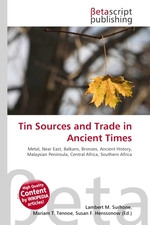Tin Sources and Trade in Ancient Times
Lambert M. Surhone, Miriam T. Timpledon, Susan F. Marseken
бумажная книга
High Quality Content by WIKIPEDIA articles! Tin is an essential metal in the creation of tin bronzes and its acquisition has been an important part of Bronze Age and later cultures throughout ancient history. Its use began in the Near East and the Balkans around 3000 BC. Tin is a relatively rare element in the Earth's crust, with approximately 2 p.p.m. (parts per million), compared to iron with 50,000 p.p.m., copper with 70 p.p.m., lead with 16 p.p.m., arsenic with 5 p.p.m., silver with 0.1 p.p.m., and gold with 0.005 p.p.m. (Valera & Valera 2003, p. 10). Ancient sources of tin were therefore rare and the metal usually had to be traded over very long distances to meet demand in areas lacking tin deposits. Known sources of tin exploited in ancient times include the southeastern tin belt running from Yunnan province in China down the Malaysian Peninsula, England, France, the border between Germany and Czech Republic, Spain, Portugal, Italy, and Central and Southern Africa (Wertime 1979, p. 1; Muhly 1979). Other minor sources of tin have been suggested in Iran, Syria, and Egypt, but the archaeological evidence is inconclusive.
Данное издание не является оригинальным. Книга печатается по технологии принт-он-деманд после получения заказа.


